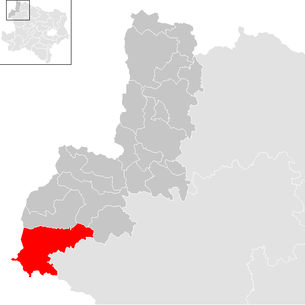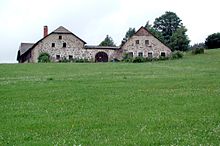Bad Großpertholz
|
market community Bad Großpertholz
|
||
|---|---|---|
| coat of arms | Austria map | |
|
|
||
| Basic data | ||
| Country: | Austria | |
| State : | Lower Austria | |
| Political District : | Gmuend | |
| License plate : | GD | |
| Surface: | 82.47 km² | |
| Coordinates : | 48 ° 38 ' N , 14 ° 50' E | |
| Height : | 714 m above sea level A. | |
| Residents : | 1.310 (January 1, 2020) | |
| Population density : | 16 inhabitants per km² | |
| Postcodes : | 3972 Bad Großpertholz 3973 Karlstift 3922 Watzmanns |
|
| Area code : | 02857 Bad Großpertholz 02816 Karlstift 02815 Watzmanns |
|
| Community code : | 3 09 10 | |
| NUTS region | AT124 | |
| Address of the municipal administration: |
Bad Großpertholz 138 3972 Bad Großpertholz |
|
| Website: | ||
| politics | ||
| Mayor : | Hermann Hahn ( FPÖ ) | |
|
Municipal Council : ( 2020 ) (19 members) |
||
| Location of Bad Großpertholz in the Gmünd district | ||
| Source: Municipal data from Statistics Austria | ||
Bad Großpertholz is a market town with 1,310 inhabitants (as of January 1, 2020) in the Gmünd district in Lower Austria .
geography
Bad Großpertholz is located in Freiwald , in the northwestern Waldviertel on the border with the Czech Republic . Of the 82.4 km² community area, 76.39 percent are forested .
Natural park
In 1987 the 526 hectare North Forest Großpertholz Nature Park was founded. It offers a showroom on the life of the woodworkers, hiking opportunities in the raised bog and themed trails.
Community structure
The municipality comprises 12 localities (population in brackets as of January 1, 2020):
- Tee (79)
- Angelbach (125) including Fischbach and Osang
- Bad Großpertholz (512) including the Brennerhof, Reinberg and Rindlberg
- Deer Stone (0)
- Karlstift (140) including Eichelberg, Gugu and Stadlberg
- Muhlbach (118)
- Reichenau am Freiwald (72)
- Discs (73)
- Seifritz (16)
- Steinbach (35)
- Watzmanns (82)
- Weikertschlag (58) including Leitenhof, Spiegelhof and Stockmühle
The community consists of the cadastral communities Abschlag, Angelbach, Großpertholz, Karlstift, Mühlbach, Reichenau, Seifritz, Steinbach, Watzmanns and Weikertschlag.
With the Lower Austria. Municipal structural improvement learned the municipal area by the incorporation of Weikertschlag (including Steinbach) 1967, fees (including Seifritz) and Watzmann (including Muhlbach) 1970 and Karl pen and Reichenau in 1971 a strong expansion.
Neighboring communities
| St. Martin | Weitra | |
| Pohorská Ves (CZ) |

|
Großschönau |
|
Sandl (Upper Austria) Liebenau (Upper Austria) |
Long strike | Great Gerungs |
history
Großpertholz was founded in the middle of the 12th century by Berthold von Schiefern-Arnstein, who built a permanent house to protect the settlement . This was expanded into a castle in the 17th century .
In 1358 Großpertholz became an independent parish .
From the 17th century, the place experienced an economic boom as a trading center for the products made in the surrounding glassworks . The widespread home weaving and the strong expansion of wood production from the 19th century onwards also ensured income and employment. In 1850 Großpertholz was constituted with the towns of Angelbach, Fischbach, Brennerhof, Holzluß, Rindlberg and Scheiben to form the municipality of Großpertholz.
In 1902 the southern branch of the Waldviertel narrow-gauge railways from Gmünd to Steinbach - Groß Pertholz was opened, the further section to Groß Gerungs the following year.
From the Second World War , the timber industry began to decline; in addition, there was the peripheral location after the First World War and to a greater extent after the Second World War. The resulting emigration can be read from the continuously decreasing population (see population development ).
In 1964 the first spa house with a mud bath was opened.
Bad Großpertholz has been the official name of the municipality since 1983.
coat of arms
Population development
After a sharp decline in population between 1951 and 2001, the decline flattens out. Above all, the strongly negative balance of migration contributes to the decline in the number of inhabitants.

politics
The municipal council has 19 members.
- With the municipal council elections in Lower Austria in 1990, the municipal council had the following distribution: 11 ÖVP, 6 SPÖ, and 2 others.
- With the municipal council elections in Lower Austria in 1995, the municipal council had the following distribution: 11 ÖVP, 6 SPÖ, and 2 list of alternatives.
- With the municipal council elections in Lower Austria in 2000, the municipal council had the following distribution: 12 ÖVP and 7 SPÖ.
- With the municipal council elections in Lower Austria in 2005 , the municipal council had the following distribution: 13 ÖVP, and 6 SPÖ.
- With the municipal council elections in Lower Austria in 2010 , the municipal council had the following distribution: 11 ÖVP and 8 SPÖ.
- With the municipal council elections in Lower Austria in 2015 , the municipal council had the following distribution: 13 ÖVP, 5 SPÖ, and 1 FPÖ.
- With the municipal council elections in Lower Austria 2020 , the municipal council has the following distribution: 8 ÖVP, 6 SPÖ, and 5 FPÖ.
mayor
- until 2005 Josef Jansen (ÖVP)
- 2005–2014 Manfred Artner (ÖVP)
- 2014–2017 Harald Vogler (ÖVP)
- 2017–2019 Klaus Tannhäuser (ÖVP)
- 2019–2020 Martina Sitz (ÖVP)
- since 2020 Hermann Hahn (FPÖ)
Culture and sights
- Catholic parish church of Bad Großpertholz Sts. Bartholomäus and Thomas: It is a baroque hall church of Romanesque origin.
- On the main square below the church there is a Trinity column from 1715.
- Großpertholz Castle in the east of the village is a baroque building, the exterior design of which is characterized by renovations in the 19th century. In the castle there is a chapel dedicated to Saints Sebastian and Florian .
- The neo-Gothic Hackelberg crypt chapel stands above the castle .
- The late baroque Karlstift parish church was built between 1772 and 1775.
- In Karlstift there is also a manor house built by the barons of Hackelberg-Landau from Großpertholz in 1828, the Trinity Chapel on Eichelberg, built in 1906, and a border column on Schanzberg.
- On the pillar erected in 1616 on the border of Lower Austria, Upper Austria and Bohemia there are pictures of the provincial saints Leopold , Florian and Wenzel .
- Steinbach's local chapel dedicated to the crucified Savior was built in 1786.
- The local chapel of Watzmanns dates from the middle of the 19th century, that of Abschlag, Angelbach and Reichenau am Freiwald from the second half of the 19th century.
- Mühlbach's local chapel, built in 1965 in place of a previous Baroque building, is consecrated to Johannes Nepomuk . In the west of Mühlbach there is a former hammer mill from the 18th century.
- North Forest Nature Park
economy
In 2010 there were 142 agricultural and forestry holdings in the municipality . As of 2011, 66 non-agricultural workplaces were also identified. The number of people in employment at home was 639 in 2011, which corresponds to an employment rate of 51.43 percent. The Wurzmühle in Bad Großpertholz, built in 1789, is the last paper mill still in operation in the Waldviertel.
traffic
- Road: The municipality is located on the priority road (formerly Bundesstraße 41) from Gmünd to Freistadt . There is a road connection to Zwettl via secondary roads .
- Rail: Regular operations on the Waldviertel narrow-gauge railway were discontinued at the end of May 2001; the route is still used for tourism as a museum railway .
health
In the market town there is a mud bath with a focus on healing mud , the musculoskeletal system and rheumatism.
Personalities
- Hermann Knapp (* 1964), writer
- Katrin Mladek (* 1989), natural toboggan runner (Reichenau am Freiwald)
- Friedrich Weissensteiner (* 1927), historian
- Sepp Koppensteiner (1898–1981) local researcher and dialect poet
Web links
- 30910 - Bad Großpertholz. Community data, Statistics Austria .
Individual evidence
- ↑ Data & facts. In: naturparke.at. Association of Austrian Nature Parks, accessed on March 18, 2020 .
- ↑ Statistics Austria: Population on January 1st, 2020 by locality (area status on January 1st, 2020) , ( CSV )
- ↑ Entry about Großpertholz Castle in Lower Austria Castles online - Institute for Reality Studies of the Middle Ages and Early Modern Times, University of Salzburg
- ^ Manfred Wagner : Lower Austria and its cultures . In: Lower Austria: A Cultural History from 1861 to Today . tape 3 . Böhlau, 2006, ISBN 978-3-205-77219-4 , pp. 260 .
- ^ Kuranstalt Moorbad Großpertholz. In: waldviertel.com. JKU , accessed on September 19, 2018 .
- ^ Statistics Austria, A look at the community of Bad Großpertholz, population development. Retrieved August 25, 2019 .
- ^ Result of the local council election 1995 in Bad Großpertholz. Office of the Lower Austrian State Government, March 30, 2000, accessed on January 18, 2020 .
- ^ Election result of the municipal council election 2000 in Bad Großpertholz. Office of the Lower Austrian State Government, February 4, 2005, accessed on January 18, 2020 .
- ↑ Results of the 2005 municipal council elections in Bad Großpertholz. Office of the Lower Austrian State Government, March 4, 2005, accessed on January 18, 2020 .
- ^ Election result of the municipal council election 2010 in Bad Großpertholz. Office of the Lower Austrian State Government, October 8, 2010, accessed on January 18, 2020 .
- ^ Election results for the 2015 municipal council elections in Bad Großpertholz. Office of the Lower Austrian State Government, December 1, 2015, accessed on March 4, 2019 .
- ↑ Results of the 2020 municipal council elections in Bad Großpertholz. Office of the Lower Austrian State Government, January 26, 2020, accessed on January 26, 2019 .
- ↑ a b c Bad Großpertholz community data. In: noe.gv.at. Accessed May 1, 2019 .
- ↑ Alpenbahnen, Waldviertelbahn. Retrieved August 25, 2019 .
- ↑ Treatment focus in the mud bath Bad Großpertholz. In: moorbad-badgrosspertholz.at. Retrieved April 19, 2020 .






